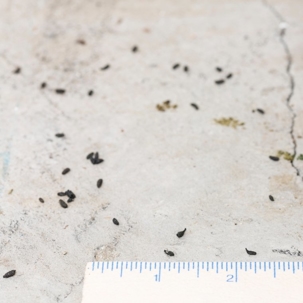What Are The Signs Of Mice?
Mice infestations can often go unnoticed at first, but there are several clear signs you can look for in both homes and businesses:
Sightings: Seeing a mouse during the day can indicate a larger problem, as they are usually nocturnal.
Dead Mice or Predation Signs: Occasionally, dead mice may be found if predators catch them, or if an infestation has been intense.
Droppings: Small, dark, pellet-shaped droppings (about 1/4 inch long). Often found near food sources, cupboards, pantry areas, or along walls. Fresh droppings are dark and shiny; older droppings dry out and look grayish.
Gnaw Marks: Mice constantly chew to keep their teeth short, leaving marks on wood, plastic, wires, cardboard, or food packaging. New gnaw marks are light-colored; older marks turn darker. Damaged wires can pose a fire hazard.
Holes or Entry Points: Small holes (about the size of a quarter or smaller) in walls, floors, or foundations. Gaps around doors, windows, vents, or pipes can be entry points.
Chewed Wiring or Cables: Mice sometimes gnaw on electrical wires, phone cords, or computer cables. Can cause short-circuits or fire hazards if left unchecked.
Damage to Food: Chewed packaging, small holes in bags, or gnawed grains and dry goods in pantries.
Damaged Upholstery or Furniture: Mice sometimes chew on furniture, insulation in sofas, or stored clothing. Shredded stuffing may indicate nesting activity.
Nesting Material: Mice build nests from shredded paper, fabric, insulation, or cardboard. Nests are usually hidden in secluded areas like behind appliances, inside walls, attics, or storage boxes.
Tracks and Footprints: Dusty or dirty areas may show tiny footprints. Tail drag marks or smudges along walls can indicate movement paths. You can sprinkle flour or powder in suspected areas to confirm activity.
Grease Marks: Mice have oily fur, so they leave smudge marks or streaks along walls, baseboards, and floor edges.
Noises: Scratching, squeaking, or scurrying sounds, particularly at night, in walls, ceilings, or under floors.
Urine Odor: A strong ammonia-like or musky odor, especially in enclosed spaces, can signal an infestation. Odor is more noticeable in areas where mice are active frequently.
Strong Musty Odor in Hidden Areas: Even if not near food, nesting inside walls, attics, or crawl spaces can emit a strong, musky smell.
Pet Behavior: Cats and dogs may become unusually alert, paw at certain spots, or bring “gifts” of caught mice or droppings.
Mice are very good at staying hidden, so these subtle signs often appear before you ever see the actual mice. Combining multiple indicators usually confirms the presence of an infestation.
Learn more: What Do Mouse Droppings Look Like?
What Things Are Not Always Signs Of Mice?
Many homeowners and business owners misinterpret certain things as evidence of mice when, in reality, they’re caused by other factors. Misreading these “false positives” can lead to unnecessary treatments or panic:
Droppings That Aren’t Mice
What it looks like: Small, dark, pellet-like droppings.
Why it’s misleading: Some insects (like large beetles), small birds, or even lizards can leave droppings that look similar.
Tip: Mouse droppings are usually uniform in size (~1/4 inch), pointed at one end, and dark brown or black. Other droppings often vary in size or shape.
Rustling or Scratching Noises
What it sounds like: Scratches inside walls, ceilings, or floors.
Why it’s misleading: Sounds can come from rats, squirrels, or other rodents (not just mice), crickets, cockroaches, and other insects, or settling pipes and other structural components.
Tip: Mice make high-pitched squeaks at night, and their movement is lighter and faster than rats or squirrels.
Small Holes or Chewed Materials
What it looks like: Tiny holes in walls, wood, or packaging.
Why it’s misleading: Some holes are caused by carpenter ants, woodpeckers, or wear-and-tear. Some gnaw marks can be from squirrels, rats, or even mechanical damage.
Tip: Mouse gnaw marks are usually about 1/8–1/4 inch wide, clean-edged, and often near food or nesting areas.
Musty or Unusual Odors
What it smells like: Musky, ammonia-like odor.
Why it’s misleading: Mold, mildew, or pet urine can produce similar odors. Some stored foods or decaying organic matter may mimic the scent of rodents.
Tip: True mouse odors are persistent and often concentrated along travel paths or nests.
Chewed Wires or Small Damage
What it looks like: Minor fraying or gnawing on cords or insulation.
Why it’s misleading: Wear and tear, pets, or sometimes even insects like termites can cause similar damage.
Pet Behavior
What it looks like: Cats or dogs acting alert, scratching, or pawing at certain areas.
Why it’s misleading: Pets may respond to insects, small birds, or even shadows.
Tip: Observe if there are actual signs of mouse activity in the area.
Random Tracks or Smudges
What it looks like: Marks in dust or dirt.
Why it’s misleading: Footprints may belong to other wildlife (rats, squirrels, lizards) or humans. Smudges may be oil, grease, or residue from other sources.
Many potential “signs” of mice are shared with other pests, pets, or environmental factors. Confirming a mouse problem usually requires multiple indicators together—droppings, gnaw marks, nests, and sightings—rather than relying on a single clue.
What To Do If You See Signs Of Mice
Calling our professional pest control team when you notice signs of mice is critical because mice are not just a nuisance—they pose serious risks to property, health, and safety. Seeing signs of mice is a red flag that should not be ignored. Mice reproduce rapidly, cause property damage, and carry health risks. Our professional pest control team ensures accurate identification, safe removal, prevention of future infestations, and protection of health and property—all of which DIY methods rarely achieve effectively.

